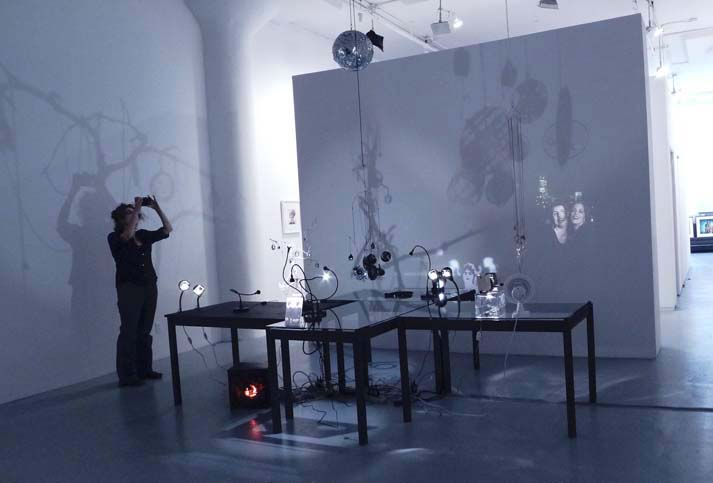Ofri Cnaani's Optics at Andrea Meislin

Can you see a trick while it's happening? While this seems like a question the FBI might want to ask a bank too large, so far, to fail, it is posed in artistic terms by Ofri Cnaani’s solo exhibition Special Effects, currently on view at Andrea Meislin Gallery
The front of the gallery is taken over by a series of low-tech image projection devices, from a slide projector to a disco ball, which together cast a ghostly bluish glow and dancing images on the walls. Among them are:
The H-21 Machine. Resembling a wind-up Victrola, the H-21 moves in and out of focus, creating a movie-on-demand. Named after Mata Hari’s German code-name, the machine operates on mostly manual terms, having originally been a pencil sharpener. Sequences stop and start, often flickering like an old-time movie. Using mostly manual dissolves, Cnaani manipulates this retrograde machine to trick viewers into believing that what they’re seeing is a digital preview. The projector is part spy lab whose functionality has been rigged, tampered with and usurped. Photograms appear to signal some kind of code or double-talk, like the devices of a double agent in action.
The Pinhole Galaxy Machine: Part intergalactic, part pinhole camera, this construction recalls the work of the Italian astronomer and philosopher, Galileo Galilei and his book Dialogue Concerning the Two Chief World Systems, written in 1632. Cnaani’s Machine is made out of of cinefoil and light to resemble the above mentioned disco ball, but it projects a galaxy of small stars and drifting planets that perform a light ballet. As for Galileo, his Dialogue was placed on the Index of Forbidden Books by the Catholic Church until 1836.
Press Hold to Talk | A Radio Play, with text by Cheryl Kaplan, uses the format of a late Victorian era “problem picture” to present a theoretical work and critique of an unresolved dilemma or social issue. The voice over starts mid-sentence, purposefully deleting the usual before and after phrases that introduce, build and establish narrative sequence and resolution. As an audience, we’re not sure what is happening at first. Are we listening to gossip? Has critical information been deleted? Are we being misled? Because the dialogue begins with a series of halts and starts, the audience feels as if it has come in late. The radio play and other elements in the exhitition stem from the idea of redundancy or impasse, alluding to errors and failure in intelligence gathering and espionage.
In addition to the moving images, the exhibition also features a series of cyanotypes and monotypes that further play out the artist’s fascination with how trickery is generated and received. Ofri Cnaani | Special Effects has been extended through June 9 at Andrea Meislin Gallery, 526 West 26th Street, NY, NY. Photo: Peggy Roalf.
05212012


